
Sea Surgeon's Dispensatory: 1 2 3 4 5 6 7 8 9 10 11 12 13 14 15 16 17 18 19 20 21 22 23 24 25 Next>>
The Sea Surgeon's Dispensatory, Page 6
Obtaining Medicines: The Traveling Surgeon
Sea surgeons were in a unique position when it came to obtaining medicines - they often traveled to places where a medicine that was costly in England was cheap and easy to obtain.
Sea surgeon John Moyle explains the surgeon's position neatly:
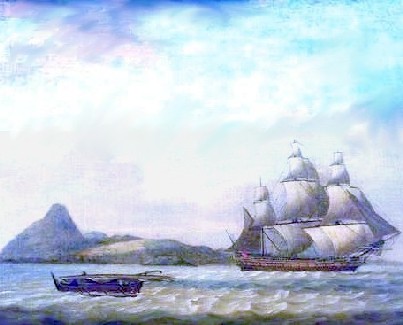
Artist: Thomas Luny - The East Indiaman Hindustan (1792)
If you are bound a Foreign Voyage; inquire what Druggs or Medicines that Country affords that you are bound unto and so to save incumbrance and expence; take only as much of such Druggs or Medicines as you judge will serve you thither.
What need you carry Rhubarb, Sena or Scamony to Smyrna, or Thriac. Andromica [Venetian Theriac] to Venice (I say, any more than will serve you thither) when as for Money or Truck [bartering], you may there have the best, and best cheap; being they are the Commodities of them places.1
Fellow sea-surgeon John Woodall hints at obtaining medicines in foreign ports while discussing the treatment of dysentery. He advises the use of "such medicines as are belonging to the chest found in the ship, or at the utmost may be found in the East Indies, or that are likely to be found there" including nutmeg, forms of cinnamon, crocus martis and treacle.2
While we have these wonderful explanations, the sea-surgeon's books from the period do not provide a lot of details on which herbs were to be obtained where, leaving this detail to the surgeon to research. Period sailor's books make up for this in a small way by providing a great deal of information on what medicines could be found where.
1 John Moyle, The Sea Chirurgeon, 1693. p. 7-8; 2 John Woodall, the surgions mate, 1617, p. 212-3
Obtaining Medicines: The Traveling Surgeon - Herbs and Plants
Sailor's books were often published as much to explain what a traveler could expect to find in foreign ports as anything else. Such details on medicine even inspired some future travelers, researchers and scientists to undertake similar voyages. Privateer William Dampier's notes on the plants in his missives were detailed enough to help and inspire several who were to follow him including naturalist and scientist Joseph Banks who made further studies of Australian plants with James Cook.1 Most sailors' accounts mention obtaining medicinal herbs and plants while in foreign ports.
Sailor Edward Barlow found 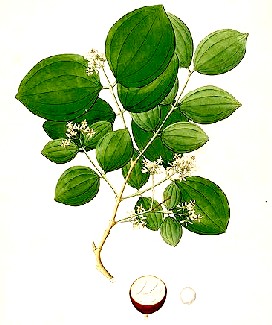
Strychnos Nux-vomica, From Plants of the coast of
Coromandel, by William Roxburgh (1795)
a variety of plants in Canton, China including 'noxvomacka' [Strychnos Nux-vomica, used to kill "such Vermine as are apt to breed in uncleanly People"2], 'galangall' [galanga, "much esteemed in Flatulencies and Indigestions"3], sago, China roots, and sugar candy"4. (Yes, sugar candy was occasionally used in medicine. Apothecary Jean de Renou explains how to make it in his Dispensatory, noting that sugar is "conducible to roughness of the tongue, asperity in the breast and to the cough"5.)
Like Barlow, Dampier found the sago tree in the Orient in Mindanao, Philippines. He said that it was useful when "dried in small pieces like little Seeds or Comfits, and commonly eaten with Milk of Almonds, by those that are troubled with Flux; for it is a great binder, and very good in that Distemper."6
Captain Alexander Hamilton discusses the use of China root, advising his readers that that which is found on "the Island of Aynam [Hainan, China] yields the best."7 Herbalist and physician Robert James says of China root, "It is thought by some to be of Service in the Gout, Sciatica, œdematous [fluid-filled] Tumors... Imbecellity of the Stomach, Hemicranias [headaches on one side of the head], and Ulcers of the Bladder and Kidneys."8
Photo: Katharina Lohrie
Ginseng Roots, Flora Farm
Hamilton also gives a detailed report on ginseng found in China.
This Root Gensing, when dried, is like a little Carrot, of a light yellow Colour, and, about Mid-way down, it branches in two, which makes the Chinese call it the Man-herb. It has a sweetish Taste, but, being much chew’d, it seems bitterish. It is cut in Shreds, and drunk with Tea, and then it is esteemed a very great Restorative of the animal Spirits. It is exceeding hot in Quality, and therefore to be avoided by those of strong Constitutions. It is excellent in Consumptions, and, for its several good Qualities, is sold at a great Price, some at three Times its Weight in Silver, but, after it is a Year old, it goes off at a Shilling per Ounce, because it is difficult to keep the Worm out of it.9
Robert James reported that ginseng was scarce in England and was "less esteem'd than it deserves". He gives it most of the same virtues that Hamilton did and several more as well, calling it a "sovereign Remedy for all Weaknesses"10.
Betel-nuts (actually areca nuts wrapped in betel leaves)
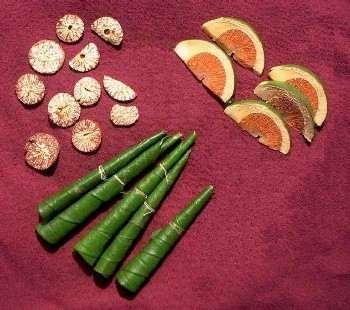
Photo: Wiki User Mohonu
Display of Betel Chewing Items - From Top Left - Slices of Dry Areca
Nuts,
Top Right - Fresh Areca Nuts, Bottom - Folded Betel Leaves
caught the attention of some of the period sailors travelling in the East Indies. Edward Barlow said it was "in great use all up and down the whole of East India, which the country people do eat or 'chaw' in their mouth, with another green leaf and a speck of white lime, so they 'chaw' it all together in their mouth, swallowing only the juice of it and spitting the rest out"11. Medicinally, he noted that it was "counted very good for the pain in the head, and other remedies"12.
William Dampier advised that betel-nut is "most esteem’d when it is young, and before it grows hard, and then they cut it only in two pieces with the green Husk or Shall on it. It is then exceeding juicy"13. Dampier further commented,
The New World provided many plants of interest to medicine, as our period sailors detail. While describing Coiba Island off Panama, Captain William Funnel, noted that it was "stored with several sorts of Medicinal HerbsIt tastes rough in the Mouth, and dies the Lips red, and makes the Teeth black, but it preserves them, and cleanseth the Gums. It is also accounted very wholsom for the Stomach; but sometimes it will cause great Giddiness in the Head of those that are not used to chew it. But this is the Effect only of the old Nut, for the young Nuts will not do it. I speak of my own experience.14
Photo: S.E. Wilco
Parthenium integrifolium or Wild Quinine
called by the Spaniards, Herba Maria."15 This is Artemisia or Mugwort, "used in Complaints peculiar, to the Female Sex"16. While it likely had commercial medical value, it would not have been of much use shipboard.
In 1709, Woodes Rogers reported finding what was likely Parthenium integrifolium (sometimes referred to as wild quinine) on Juan Fernandez Island. He provides a lengthy description of the plant, explaining that it is
a Herb found by the water-side which prov'd very useful to our Surgeons for Fomentations; 'tis not much unlike Feverfew, of a very grateful smell like Balm, but of a stronger and more cordial Scent: 'tis in great plenty near the Shore. We gather'd many large Bundles of it, dry'd 'em in the shade, and sent 'em on board, besides great quantities that we carry'd in every Morning to strow the Tents, which tended much to the Speedy Recovery of our sick Men, of whom none died but two belonging in the Dutchess, viz. Edward Wilts and Christopher Williams.17
It is interesting that the surgeons made use this plant without knowing what it was. This may have been due to the fact that someone recognized it as being 'not much unlike Feverfew.' It indicates that surgeons were willing to make use of local remedies.
Rogers mentioned several other herbs found on Juan Fernandez Island including "Parsley, Purslain, Sithes [chives] in great
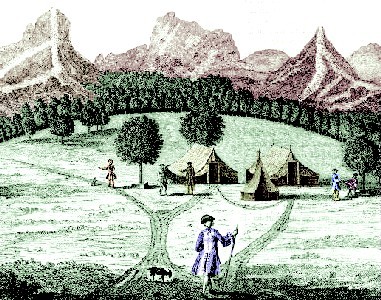
Juan Fernandez Island, from Voyage Autour du Monde, by Richard Walter (1751)
plenty"18. Let's look at each of their medicinal properties.
Parsley is familiar to most people as a rather redundant garnish, but it was considered to be one of the five opening roots during period, used to open obstructions in the body. Robert James notes that it is "attenuating [reduces the virulence of fevers], opening, detergent [cleansing], and diuretic, and is principally used in Obstructions of the Lungs, Liver, Kindneys, and gall Bladder."19
Purslane was considered one of the 'four lesser cold seeds', referring to its humoral property. Lesser cold seeds would be used against lesser hot medical problems. Physician James says it is an "excellent Aliment and Medicine; its Parts are very succulent, and the Juice astringent [able to contract the body's tissues & stop bleeding], remarkably aperient [relieved constipation], expulsive, and cooling in inflammatory Diseases"20.
James gives Sithes or chives the same "Virtues with the Onion"21, which he explains are "heating, drying, inciding [resolving - able to break up], aperient, and provocative [stimulating]. It excites an Appetite, and destroys worms in the intestines."22
Rogers and Edward Cooke both discuss the maguey plant
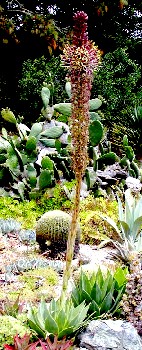
Photo: Stan Shebs
Agave chiapensis in bloom
(or agave) seen on Roger's privateering voyage. Rogers simply notes that its "leaves are admirable against Burnings; the Fruit is like Myrtle-Berries, and of an excellent Relish."23
The normally less verbose Cooke has much to say about agave, however. He explains that the plant is "very beautiful, the Leaves admirable against burning, the Fruit black like a Myrtle-Berry, very well relish’d, having an agreeable Mixture of Sweet and Tartness"24. He later discusses what appears to be another type of agave. "The Juice of the Leaves is very bitter, and serves to take Stains out of Linnen, and cleanse Ulcers, or allay Swellings in Sores."25 He also says,
The Silk Grass, or Maguey Plant, is very plentiful in New Spain; from the Leaves of it the Spaniards draw something like Hemp, to make Ropes, Sacks, Shirts, and several Sorts of curious Works. It also yields a Liquor to drink, Honey and a good Balsam. The Liquor, as it comes from the Plant, is as sweet as Sugar, some Time after becomes like Mead, and is good for the Strangury [frequent, labored urination], and other Distempers. The Indians put it into a Root, which causes it to ferment and work up like Wine, and then it will make them drunk, and is call’d Pulche [pulque].26
It is interesting that Cooke mentions this plant in three different places in his book, each representing his contact with it in a different location during the voyage. The first quote is from Cooke's description of Chile, the second is from Peru and the third is from a stop in the Galapagos Islands. His description of different plant qualities suggests he is probably discussing different species of agave plant.
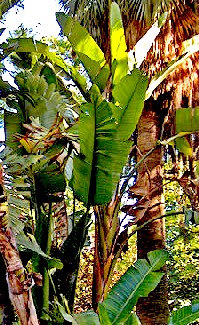
Photo: Patricia R. - Musa Paradisiaca
Photo: H. Zell -
Plantago Major
In his description of pirate captain Howell Davis, Charles Johnson mentions the leaves of 'plantane' banana plants are "an admirable Detergent, and, externally applied, I have seen cure the most obstinate scorbutick Ulcers."27
Robert James comments on the plantain tree, which is actually from the Musa paradisiaca plant, but has nothing to say about the medicinal qualities of the leaves. He only notes that they are "sometimes so large, that a Man may cover his whole Body with one of them", suggesting that they are a more probable covering for Adam and Eve than a fig leaf.28
It is likely that Johnson only heard about this plant's properties and was confusing the Musa plantains with the plantago plants, which are also referred to during this time as plantains. Of plantago plants, James says their "bruised Leaves are good to cleanse and consolidate old Wounds and Ulcers"29, which agrees with Johnson's comment.
Edward Cooke talks about two other now familiar plants. The first, he explains are called pears by the Spanish and by the natives 'palta'. We call them avocados. He advises that they are "very pleasant, and good for Sick persons."30 Physician James says that avocados (which he calls 'Spanish pears') are "good for the Stomach"31. The other product mentioned by Cooke is cocoa 'juice' (from chewing the leaves) which "preserves the Body from many Diseases; and our Physicians use it powder’d, to allay Swellings in Sores, strengthen broken Bones, expel Wind, and to cleanse foul Wounds."32
1 "William Dampier", wikipedia.com. gathered 4/18/15; 2 John Quincy, Pharmacopoeia Officinalis & Extemporanea, 1719, p. 205; 9 Quincy, p. 85; 4 Edward Barlow, Barlow’s Journal of his Life at Sea in King’s Ships, East and West Indiamen & Other Merchantman From 1659 to 1703, p. 517; 5 Jean de Renou, A Medicinal Dispensatory, pp. 224; 6 William Dampier, Memoirs of a Buccaneer, Dampier’s New Voyage Round the World -1697-, p. 214; 7 Alexander Hamilton, British sea-captain Alexander Hamilton's A new account of the East Indies, 17th-18th century, p. 537; 8 Robert James, Pharmacopœia universalis, p. 289; 9 Hamilton, p. 536-7; 8 James, p. 26; 11,12 Barlow, p. 191; 13,14 Dampier, p. 219; 15 William Funnell, A Voyage Round the World, p. 137; 16 Quincy, 1719, p. 90; 17 Woodes Rogers, A Cruising Voyage Round the World, p. 76; 18 Rogers, p. 76; 19 James, p. 400; 20 James, p. 410; 21 James, p. 435; 22 James, p. 478;23 Rogers, p. 188; 24 Edward Cooke, A Voyage to the South Sea and Round the World in the Years 1708 to 1711, p. 66; 25 Cooke, p. 194; 26 Cooke, p. 313-4; 27 Captain Charles Johnson, A general history of the pirates, 3rd Edition, p. 199; 28 James, p. 374; 29 James, p. 407; 30 Cooke, p. 193; 31 Cooke, p. 194-5; 32 James, p. 398
Obtaining Medicines: The Traveling Surgeon - Woods
Foreign wood used as a medicinal are mentioned by several authors as well. Edward Barlow reported 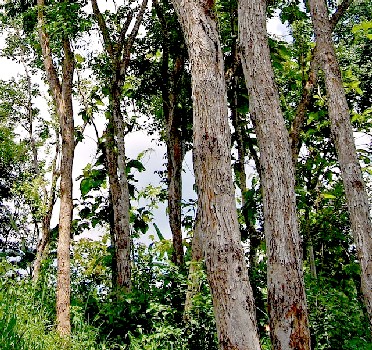
Photo: Wibowo Djatmiko - Rosewood Trees (Dalbergia latifolia)
finding "rose-wood for 'apothicaries' on Tenerife in the Canary Islands1. Apothecary John Quincy calls rosewood 'Aspalathi' which he explains may be better referred to as a root. It is "accounted astringent and drying; but tho' much in use amongst the Antients, 'tis almost quite rejected out of internal Medicines now."2
In Guayaquil, Ecuador, privateer Woodes Rogers found an "abundance of Mangroves and Sarsaparilla, which impregnates its Water, and makes it good against the French Pox [syphilis]"3. Discussing the same voyage, Captain Edward Cooke also mentioned that the Mangrove/Sarsaparilla water cocktail was effective cure for syphilis.4 Physician Robert James agrees that it is good remedy for syphilis as well as arthritis and rheumatism.5
Cooke also mentions sandalwood, advising that it is "very odoriferous, whereof there are great Quantities in the Island of Juan Fernandes, much us'd as a preservative against Infection."6 Rogers says the wood "is very odiferous, a Preservative against infectious Distempers, and therefore us’d by the [Chilean] Priests when they visit the Sick."7 Apothecary Nicholas Culpeper notes that this wood and its chips (which he refers to as sanders or 'Santalon' after the Latin name santalinus) "stops defluxions from any part, and helps inflammations"8.
Guaiacum trees, mentioned on the previous page, were discussed in some period sea journals with Woodes Rogers proclaiming them to be the "most remarkable Trees" in Europe. Of their medicinal properties, he simply notes, "The Decoction [of the wood] is good against many Diseases."9 Edward Cooke doesn't expand much upon Rogers' description of the trees' medicinal qualities, although he does provide some interesting details about its other uses. "The Gayac grows on the Mountains, a very beautiful Wood and the Balls made of it to play at Billiards, as hard as Ivory; the Decoction of it good for several Distempers."10
1 Edward Barlow, Barlow’s Journal of his Life at Sea in King’s Ships, East and West Indiamen & Other Merchantman From 1659 to 1703, p. 144; 2 John Quincy, Pharmacopoeia Officinalis & Extemporanea, 1733, p. 78; 3 Woodes Rogers, A Cruising Voyage Round the World, p. 102; 4 Edward Cooke, A Voyage to the South Sea and Round the World in the Years 1708 to 1711, p. 76; 8 Robert James, Pharmacopœia universalis, p. 426; 6 Cooke, p. 66; 7 Rogers, p. 187-8; 8 Nicholas Culpeper, Pharmacopœia Londinesis, p. 16; 9 Rogers, p. 102; 10 Cooke, p. 66
Obtaining Medicines: The Traveling Surgeon - Animal Parts
In addition to the medicinal trees and plants, period sailors recorded the medicinal use of parts of animals found in foreign locations. All of them involve sea creatures, which sort of makes sense given that they are found in sailor's accounts.
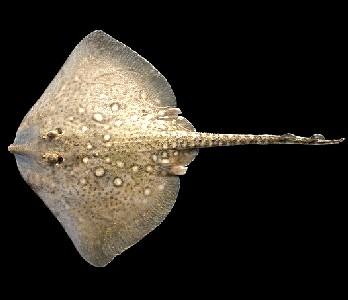
Photo: Hans Hillewaert - Thornback Ray (Raja clavata)
Friar Dominic Navarrete, who traveled to and worked in China mentions that an 'excellent fish' "is found there which is commonly call’d Piscis Mulier, or Woman-Fish, of the Bones whereof Beads of great value are made, because they have a singular virtue against Defluxions [fluxes or diarrheas]"1. The 'Woman-Fish' usually refers to dugongs.
Navarrete mentions another fish bone with medical merit; the "flat Bone at the tip of that Fishes [Thornback Rays] Tail which is an excellent Remedy for the Tooth-ach for scratching with that Bone takes away the Pain, but it must be cut off while the Fish is alive."2
Two different authors discuss what is most likely the otolith of a shark – a calcium carbonate mass which is part of the inner ear, located near the eye. Captain Edward Cooke discusses them in his account of Woodes Rogers privateering voyage, simply commenting that "the Surgeon generally saves [them], being
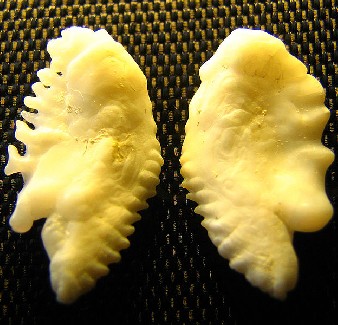
Photo: Matthieu Godbout -
Otoliths From Ocean Perch
good for several Uses."3 Captain William Funnell also gives an account of them, providing a little more detail.
He [the shark] hath two Stones between his Eyes, which are accounted very good if taken inwardly by any one that has the Stone or Gravel [bladder stones]. These Stones [otoliths] we commonly take out and give to our Doctor, who makes use of them as he finds occasion: When they are taken out of the Head, they are a perfect Jelly; but being laid in the Sun and dryed, they look like damp Chalk.4
William Dampier mentions another sort of 'stone', this one found in alligators. While in Port of Sallagua (today called Manzanillo in Mexico), Dampier reported that the natives advised the best remedy for a dropsy (edema) was "the Stone or Cod of an Allegator (of which they have four, one near each Leg, within the Flesh) pulverized and drunk in Water: The Recipe we also found mentioned in an Almanack made at Mexico: I would have tried it, but we found no Allegators here, though there are several."5 What he is talking about here is not clear.
None of these things are included in the period dispensatories and appear to be nothing more than folk remedies. It is curious that the surgeons would be so interested in the otolith of sharks, although two unrelated accounts mentioning it suggest it had some support from period sea surgeons.
1 Domingo Navarrete, The Travels and Controversies of Friar Domingo Navarrete 1618-1686, p. 81; 2 Navarrete, p. 83;3 Edward Cooke, A Voyage to the South Sea and Round the World in the Years 1708 to 1711, p. 26; 4 William Funnell, A Voyage Round the World, p. 6-7; 5 William Dampier, Memoirs of a Buccaneer, Dampier’s New Voyage Round the World -1697-, p. 178

